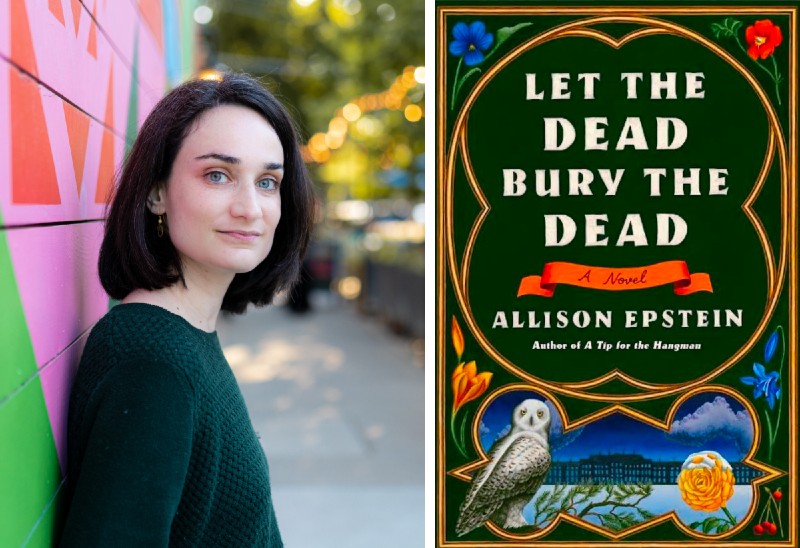Fables of the Deconstruction: Allison Epstein’s second novel uses Eastern European mythology to create queer historical fiction

Allison Epstein says Let the Dead Bury the Dead is “my COVID novel, for sure."
She started writing it in 2019 and "most of the drafting and rewriting happened while I was in lockdown, looking for something to do.”
The book is set in 1812 in a partially reimagined St. Petersburg, Russia, where a band of revolutionaries, the Koalitsiya (loosely based on the Decembrists), plot against the tsar, while the tsar’s second son decides whether or not to join them.
The Chicago-based Epstein, who earned her Bachelor of Arts in creative writing from the University of Michigan, also wrote historical fiction in her first novel, A Tip for the Hangman, based on the 16th-century life of playwright and alleged spy Christopher Marlowe.
Epstein says the inspiration for Let the Dead Bury the Dead came from another book set in the same period and country.
“I ended up re-reading War and Peace over COVID. I think we were all just, like, ‘What do I do with myself? Let's pick up the biggest book I can find.’”
Epstein’s story follows three primary characters: Felix, the fickle, apparently feckless Grand Duke, who’s gradually won over to the side of the proletariat; Sasha, Felix’s guard and long-time lover, who’s skeptical of Felix’s revolutionary new interests; and Marya, the tough-as-nails thief and second-in-command to the Koalitsiya.
Then there’s the mysterious silver-haired Sofia, who may or may not be human, and who appears one day out of the blue like something (or someone) from a folktale.
In fact, chapters are interspersed with reinterpreted fables rooted in Russian, Serbian, Polish, and “pan-Slavic” legends, Epstein says.
“I've twisted all of them a little bit to make them my own—they’re a little bit queerer and sexier than the originals tend to be,” she says.
“What I wanted this book to play around with a little bit is the line between fantasy and reality.”
To that end, Epstein not only allows fantastical elements to occur—Sofia might be a vila (Slavic fairy) or a witch—she also veers away from history as it actually happened.
Rather than the real-life Romanov imperial family, Epstein gives us the invented Komarov dynasty. Plus, Epstein’s queer characters get a little more breathing room for their relationships than they would’ve gotten in “real” life.
“I am so tired of reading homophobic books,” Epstein says.
“And queer historical fiction is my happy place,” she goes on. “That's my genre. I read a lot of it. It's what I enjoy writing. And I feel like there are kind of two roads that you can choose to go down. ... The quote-unquote period typical homophobia, which is just, ‘Oh, I love you, but no one can know about it. ... Our tragedy is that we are queer and we can't tell anyone.’ Or it can be: ‘Our tragedy is we’re caught up in this moment in history and we're dealing with things—also, we’re queer.’ And for me, I feel like I haven't read as many of that second option as I have of the first and so I feel like it's time for historical queer characters to get to have problems that are other than being queer.”
Epstein says she can see herself in the book’s main characters and "can point to the piece of myself in all of them, and it's a different piece,” she says. That’s especially true about Sasha, Felix, and Marya, Epstein says: “That’s what would happen if you separated me out into three people.”
Sasha, the guard, reveals the part of Epstein that is “really following it by the book, following it by the letter—‘We follow the rules here, we know what we're gonna do and we're gonna do it’…If you took that to its absolute, you would end up with someone like [Sasha],” Epstein says.
“For Felix,” she says, “kind of the opposite—like, ‘I don't feel like following anybody's rules, I'm just here to have a good time, leave me alone. Let me have my party.’ There’s part of me in that, too.”
But Epstein says the character she most identified with was Marya, the unlikely hero of the Koalitsiya.
“She, I think, never, never wants the story to be about her. But the story insists on making her a central part of it, anyway. And she just wants to follow the beliefs that she has behind somebody else, but the story thrusts her into a spotlight that she doesn't want. And as someone who really does not like anybody looking at them or perceiving them, I felt a kinship with that.”
Natalia Holtzman is a freelance writer. Her work has appeared in the Los Angeles Review of Books, The Millions, LitHub, the Minneapolis Star Tribune, and elsewhere.
Allison Epstein will discuss "Let the Dead Bury the Dead" with Genevieve Gornichec at Literati Bookstore, 124 East Washington Street, Ann Arbor, on Wednesday, October 25, at 6:30 pm. Visit literatibookstore.com for more information.


































